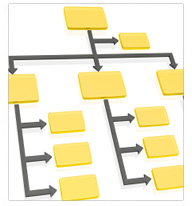Although you might have first-rate content on your price per head bookie website, if it’s not organized properly, it will be difficult for  Google’s web crawlers to link it to related searches.
Google’s web crawlers to link it to related searches.
Bookie Website: Understanding Siloing
This is the main reason why you, as the webmaster of your pay per head bookie website, should seriously consider the option of siloing, which is the way in which you can organize a site into subject themes by grouping certain pages together.
Siloing makes it possible for you to channel link equity to the different pages of your site. This reinforces to Google the relevancy of such pages related to the keywords contained within them.
There are two parts to the siloing process: 1. Internal Linking and 2. Site architecture. Siloing means that the links on your sportsbook bookie website are well organized. This process is very important because Google gets more information concerning your site from the anchor text of your links than from the content itself.
Checking the Competition
By looking at the sites of your top competitors, you can get a good idea of how they are organizing their content. This can help you in two ways:
- You can figure out how well structured their sites are. If they are not using siloing, you can get an advantage over them by using it yourself on your bookie website.
- If they do use siloing, you can copy their system in order to compete for a top position in the SERPs.
Are your Competitors Siloing?
The structure of your competitors can give you some clues: For example, if you see that a site about cars is organized first by maker (Land Rover) and then by model (Discovery) then it is likely that the content of such site is siloed.
Look at this URL: carsite.com/land-rover/discovery/customize-your-discovery.htm
Now look at this one: carsite.com/fgtds/php?t=75645&_cthew=15%2B1
The first example is of a site that is working with a siloing process and the latter is for one that utilizes parameters and codes. Although the second URL will still direct users to the desired page, it will hurt your reputation with the web crawlers because they prefer to index content from pages that have meaningful keyword phrases in their URL’s.
Visitors of your bookie website also appreciate the clarity of your siloing because they are able to identify exactly where they are and how they got there. They will certainly prefer to navigate your site than to visit the site of an agent that doesn’t have the content of his or her site siloed.
Competitors’ Internal Links
You can also tell if a competing site is organized into silos by taking a look at its internal links. These are not the ones from the navigation menu, but the hyperlinks located within the competitor’s landing pages. Check if there are direct links to supporting pages and as you visit the secondary pages, verify if they have links directed to the top landing page but not to off-topic pages. If that is the case, then such site is using silos.
On the other hand, if they don’t work with silos, you might see:
- Zero links related to the top landing page.
- Exactly the same set of link on all pages you check.
- An assortment of links to different areas of the site without a main subject focus.
Creating a Site Map
A site map not only will help you to comply with Google’s rules but it will also make it easier for visitors to find a certain page on your bookie website. Try to make your site map as schematic as possible so it can outline the entirety of your site’s structure.